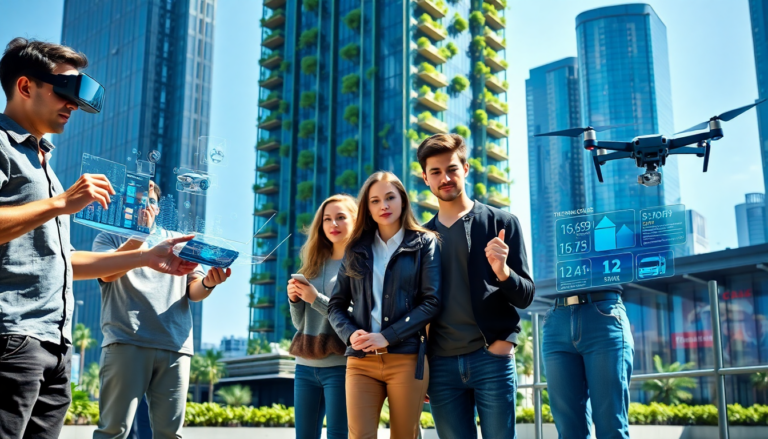Argomenti trattati
The World Economic Forum has just released its latest report, spotlighting the Top 10 Emerging Technologies for 2025. These innovations are set to change the way we live, from advancements in artificial intelligence to groundbreaking developments in clean energy. As we stand on the brink of a technological renaissance, it’s crucial to understand these innovations if we want to navigate the future effectively.
Breakthrough Technologies on the Horizon
This year’s report, unveiled at the Forum’s Annual Meeting of the New Champions, showcases ten key technologies that are on the verge of becoming part of our everyday lives. The selection is based on factors like novelty, development stage, and potential societal benefits. Jeremy Jurgens and Frederick Fenter, the report’s authors, state, “By identifying technologies at their turning point, we provide leaders in government, business, and science with insights needed to make forward-thinking decisions.” But what exactly does this mean for us?
One of the standout trends is technology convergence. Think about how artificial intelligence is merging with biological systems or how new materials are being utilized to create sustainable energy solutions. These technologies aim to tackle significant global issues such as misinformation, pollution, and climate change—all within the next three to five years. Isn’t it fascinating to consider how these innovations could reshape our world?
Innovations that Matter
One noteworthy technology to keep an eye on is structural battery composites (SBCs). These integrate energy storage into weight-bearing materials, which is a game-changer. Unlike traditional lithium-ion batteries that take up dedicated space, SBCs can be used in electric vehicles and aircraft. This could potentially make them lighter and more efficient. However, regulatory challenges still pose hurdles for widespread adoption. If we can overcome these challenges, the environmental and economic impacts could be enormous.
Another exciting development is osmotic power systems, which generate energy from the salinity gradient between two water sources. This concept, although proposed back in the 1970s, is gaining traction thanks to recent advancements in materials and design. Two types of systems—Pressure Retarded Osmosis and Reverse Electrodialysis—are harnessing this potential to create clean, renewable electricity. How cool is that?
As Bernard Meyerson of IBM puts it, “The Earth tries to reach equilibrium, leading to pressure generation when water moves across a membrane.” This process could be crucial for developing sustainable energy solutions that mitigate environmental damage.
Health Innovations and Future Prospects
Shifting gears to health, scientists are exploring the use of genetically engineered probiotics that can produce therapeutics right within the body. This innovation could lead to more effective and cost-efficient treatments, reducing our reliance on lab-produced drugs. Imagine programming these living therapeutics to control medication production—providing a continuous supply for patients who need regular doses.
Additionally, there’s promise in Glucagon-like peptide-1 receptor agonists (GLP-1 RAs), initially developed for obesity and type 2 diabetes. These drugs are showing potential in treating neurological diseases like Alzheimer’s and Parkinson’s. As Mariette DiChristina notes, “Think about the caregivers and the time they spend on care that could be allocated to other life-affirming activities.” The ability of these drugs to reduce inflammation and remove toxic proteins could significantly improve care for millions suffering from dementia.
Real-time monitoring technologies are also making headway. Autonomous devices that detect biochemical changes are being developed for various applications, from diabetes management to environmental safety. Continuous, wireless monitoring can alert users to health or safety issues in real time. Isn’t it amazing how technology is evolving to keep us safer and healthier?
Addressing Global Challenges
As we face the realities of climate change, the World Economic Forum emphasizes the urgent need to transition to clean energy. Right now, fossil fuels are still the dominant source of energy worldwide, significantly contributing to emissions. The Forum’s Energy Transition Index highlights the challenges that major emitters like the US and China face in adopting more sustainable practices. What will it take for these powerful nations to make the necessary changes?
To encourage a more sustainable energy system, initiatives like the Mission Possible Partnership are vital. This collaboration aims to align public and private sectors towards achieving net-zero emissions, particularly in heavy industry and mobility. The future of energy depends on effective policies and innovative solutions that balance economic growth with environmental responsibility.
In conclusion, the technologies highlighted in the World Economic Forum’s report not only represent thrilling advancements but also hold the potential to tackle some of humanity’s most pressing challenges. As these innovations evolve, their successful implementation could transform our world in the coming years, leading us toward a more sustainable and healthier future. Are you ready to embrace the change?

